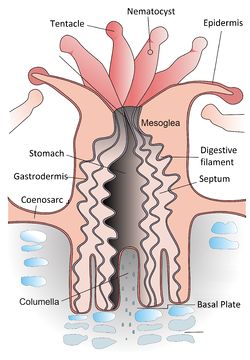CoralPolyps
Coral Polyps
Corals belong to the Ppylum Cnidaria and class Anthozoa. Corals exist as individual polyps or in colonies.[1].
- talk about what a Polyp is and where they are found [2]
Anatomy

Coral polyps are multicellular organisms with limited organ development. The average polyp grows to 1-3mm in diameter and can exist as a solitary individual or as a group of interconnected polyps called a colony. Colonial polyps are connected by the coenosarc, allowing polyps to communicate and share nutrients. Similar to cnidarians, polyps contain three body tissues: epidermis, mesoglea, and gastrodermis. Corals are categorized as scleractinian, or hard corals, or Alcyonacea, or soft corals depending on whether or not they produce a calcium carbonate skeleton.[1]
Corals that create a rigid calcium carbonate skeleton are the hard corals. These are the primary corals involved in reef building and are termed hermatypic. Typically, scleractinian coral polyps are characterized as having sets of six tentacles, septa, and mesenteries. The tentacles encircle the mouth and are used in defense and the capturing of prey. They contain stinging cells called nematocysts. These poison-injecting are used to incapacitate small prey, as well as deterring predators. The mouth is the only opening to the gastrovacular cavity and is used to ingest food and expel waste. The gastovascular cavity contains mesenteries, which internal folds that increase the surface area of the stomach. Mesenteries are known to contain mesenterial, or digestive, filaments that aid in food capture. The mesenteries are supported by septa.[1]
Hard coral polyps attach to the substrate via the calyx and basal plate. Calcium carbonate is secreted at the base of the animal. As polyps die, they leave the secreted calcium carbonate skeleton behind. In living scleractinian coral colonies new polyps will grow in place of the dead polyp. The build up of calcium carbonate over time leads to the formation of coral reefs.[1]
Soft coral polyps are similar in structure to those of hard corals. However, ahermatypic corals do not have calyx, septae, or basal plates and do not secrete calcium carbonate. The polyps are also characterized as having tentacles and mesenteries grouped into sets of eight. These corals are often specialized for filter feeding.[1]
- Describe the different parts that make up the Polyp and what they do. (Tentacle, mouth, basal plate, etc.)[3]
- Explain how nerve cells loosely connect Polyps to one another creating a nerve net between a colony of Polyps
Symbiotic relationship with zooxanthellae
- Define symbiosis.
Symbiosis can be defined as any of several living arrangements between members of two different species. Symbiotic relationships can be categorized into three different types including, mutualism, commensalism, and parasitism. The species involved in these relationships are called symbionts. In a mutualistic symbiotic relationship both species involved benefit. An example of this type of relationship is the one between oxpecker birds and rhinos. An oxpecker birds will land on the back of a rhino and eat the ticks, fleas, and other parasites that live on them. Both symbionts benefit. As the oxpecker receives nutrients from eating the parasites the rhinos are getting rid of the parasites feeding on them.[4]. In commensalism one symbiont, called the commensal, benefits from the relationship while the other symbiont, called the host, remains unaffected. An example of this type of relationship could be when smaller fish follow bigger fish in order to eat leftover food. The smaller fish benefit by gaining nutrients from the left over food while the bigger fish are unaffected as they are already done with the food.[5]. Parasitism is a non-mutual symbiotic relationship between species where one species, the parasite, benefits at the expense of the other, the host. A classic example of this type of relationship is when a tapeworm attaches itself to the insides of the intestines of other animals and feed on the food that the animal ingests. The parasite benefits by gaining nutrients, but does so at the expense of the host because it now needs to eat more in order to survive.[6].
- Explain how Polyps and Zooxzanthellae have a symbiotic relationship. (what each does for each other)[1]
- Explain how through this relationship both are mutually benefited.
- Explain how the relationship is also obligative. Meaning that, in most cases, neither can live without the other.
Stony Coral and Soft Coral Coral
- Stony corals make a calcium carbonate skeleton, soft corals do not do this
Feeding
- How Polyps are able to use their tentacles to pull in zooplankton and small fish to their mouths
Reproduction
- Explain the process of reproduction
References
- ↑ 1.0 1.1 1.2 1.3 1.4 1.5 NOAA, NOAA Coral Reef Conservation Program Coral 101. NOAA. Web. 5 Mar 2014. <http://coralreef.noaa.gov/aboutcorals/coral101/>.
- ↑ Gray, Susan Heinrichs. Coral Reefs. Minneapolis, Minn: Compass Point Books, 2000. eBook Collection (EBSCOhost). Web. 22 Feb. 2014.
- ↑ Pechenik, J. A. . Biology of the invertebrates. sixth. McGraw-Hill, 2010. print.
- ↑ "Mutualism(biology)." . Wikipedia, 14 Mar 2014. Web. 1 Apr 2014. <http://en.wikipedia.org/wiki/Mutualism_(biology)>.
- ↑ "Commensalism." . Wikipedia, 25 Mar 2014. Web. 1 Apr 2014. <http://en.wikipedia.org/wiki/Commensalism>.
- ↑ "Parasitism." . Wikipedia, 26 Mar 2014. Web. 1 Apr 2014. <http://en.wikipedia.org/wiki/Parasitism>.